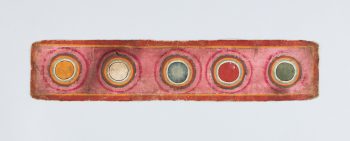Tibet
ca. 15th century


Tibet
ca. 15th century


This is the uppermost page of a manuscript that illustrates the contents of the Bardo Thodrol known as the Tibetan Book of the Dead in the West—a teaching revealed by treasure revealer Karma Lingpa (14th century), which describes the intermediate state between death and rebirth, known as the bardo. This section of the manuscript depicts five circles that serve as a mnemonic symbol of the five elements that constitute our psychophysical individuality: earth (yellow), water (white), fire (red), air (green), and space or quintessence (blue). They dissolve in succession at the time of death, thus propelling the mental principle of the deceased into the bardo of the afterlife.
Teachings and precepts that offer practical and experiential guidance. In Buddhism instruction is primarily an oral tradition and is often targeted to the specific needs or disposition of a student or disciple.
The end of this life marked by the cessation of bodily functions followed by decay. According to Buddhism, after death consciousness transitions to an intermediate state known as the bardo before embarking on another life.
A meditation technique primarily used in tantric practice that involves imagining a deity in one’s mind or imagining oneself becoming a deity and carrying out various activities. Such techniques are intended to help a practitioner transform ordinary perception and achieve enlightened qualities.
Today, Tibetans primarily inhabit the Tibetan Plateau, situated between the Himalayan mountain range and the Indian subcontinent to the west, Chinese cultural regions to the east, and Mongolian cultural regions to the northeast. During the 7th to 9th century, Tibetan rulers expanded their empire across Central Asia, and established Buddhism as the state religion.
Get the latest news and stories from the Rubin, plus occasional information on how to support our work.